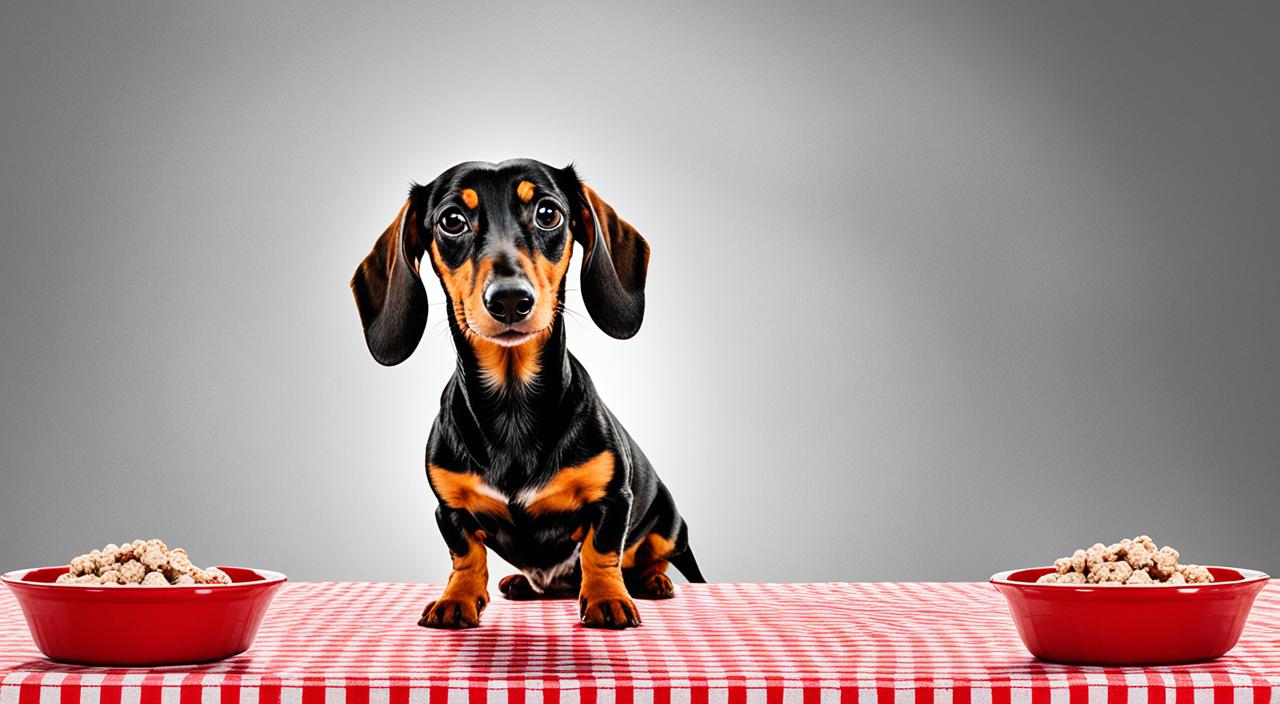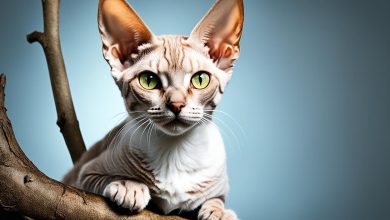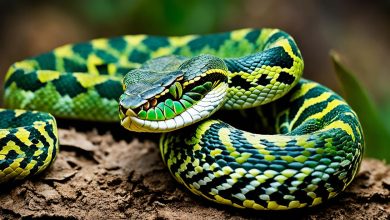Dachshunds, or sausage dogs, are pint-sized pups with outsized personalities. Their long bodies sway as they waddle, stealing hearts worldwide. These cute dogs boast a rich history and unique charm.
German breeders created Dachshunds to hunt badgers. Their short legs and long torsos make them easy to spot. People often call them doxies or badger dogs.
Dachshunds come in various sizes and coat types. You can find smooth-haired, long-haired, and wire-haired varieties. They range from miniature (11 pounds) to standard (up to 32 pounds).
These dogs are smart and spirited, not just adorable. In 2022, they ranked 9th in AKC registrations. Dachshunds win over dog lovers with their playful nature.
If you want a loyal companion or feisty friend, consider a Dachshund. They might be the perfect fit for your family.
The Origins of the Dachshund
The Dachshund, also called the badger dog or teckel, has German roots. This beloved breed emerged in the 15th century. It was bred for a specific purpose that shaped its unique traits.
German Roots: The Badger Hunter
German hunters created the Dachshund to chase badgers into their burrows. Their long, low bodies were perfect for digging and navigating underground tunnels. This design made them valuable hunting companions.
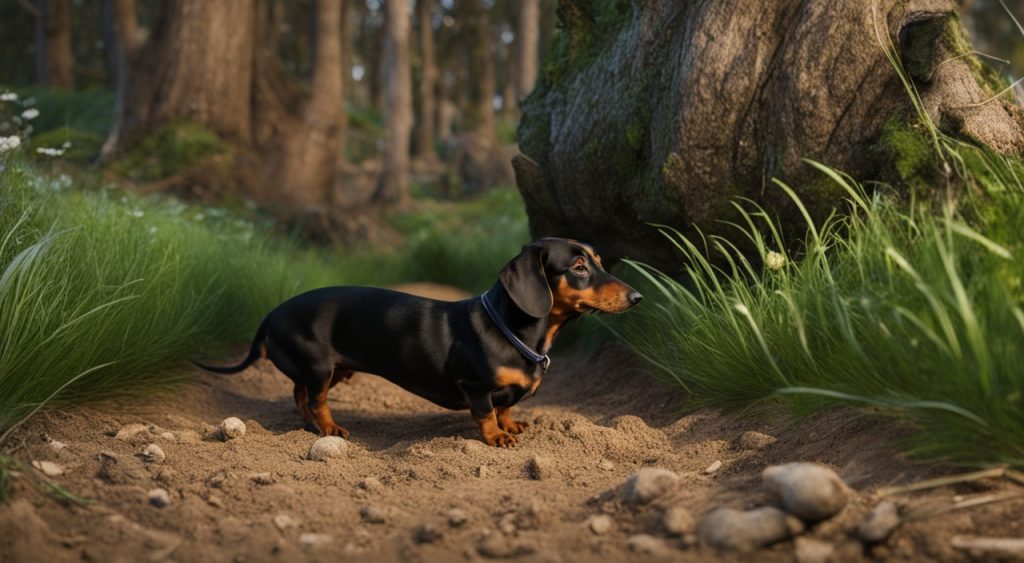
Evolution of the Breed
As the breed developed, two main sizes emerged. The Standard Dachshund hunted badgers and wild boars. The Miniature Dachshund pursued rabbits and other small game.
Today, the breed has three coat types: smooth, long-haired, and wire-haired. Each type suits different terrains and weather conditions.
Historical Significance in Germany
Dachshunds became a symbol of Germany, influencing their popularity worldwide. During World Wars I and II, their German association led to a decline in some countries.
Despite this, the breed’s charm and versatility helped it recover. Dachshunds have secured their place in hearts globally.
| Dachshund Type | Primary Prey | Weight Range |
|---|---|---|
| Standard | Badgers, Wild Boars | 16-32 lbs |
| Miniature | Rabbits, Small Game | Less than 12 lbs |
| Kaninchen (Rabbit) | Smaller Prey | 8-11 lbs |
Physical Characteristics of Dachshunds
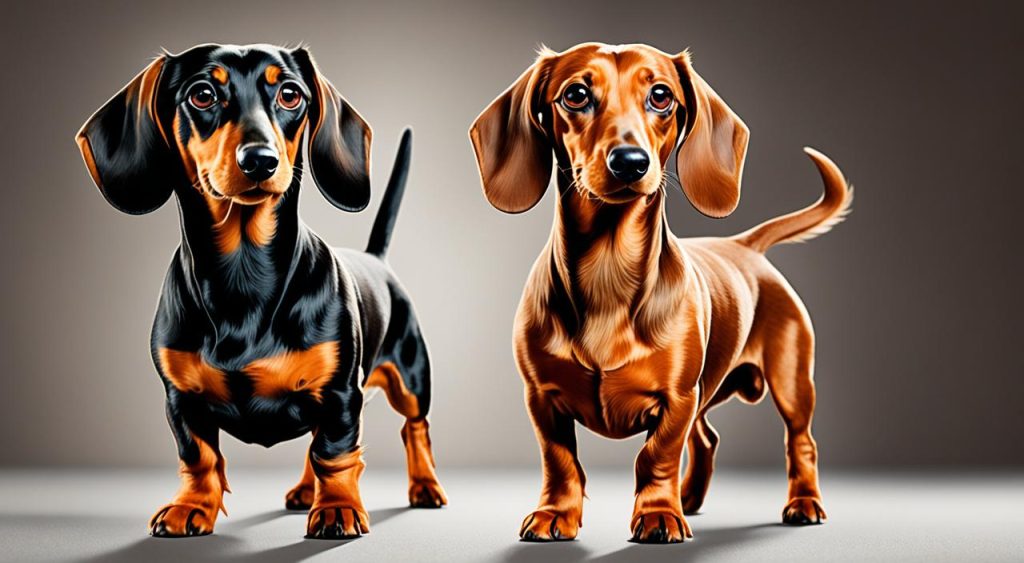
Dachshunds are famous for their unique, elongated body shape. These “low-rider” dogs have long, muscular bodies and short legs. Their build makes them perfect for burrowing and hunting in tight spaces.
Standard Dachshunds usually weigh between 16 and 32 pounds. Miniature Dachshunds are lighter, weighing 11 pounds or less. Most Dachshunds stand about nine inches tall at the shoulder.
Dachshunds have oversized, paddle-shaped front paws ideal for digging. Their long snouts and floppy ears add to their charm. These features also enhance their hunting abilities.
Their loose, elastic skin protected them from injury while tunneling after prey. Dachshunds’ eye colors vary, with darker shades preferred in breed standards. Some may have striking multi-colored eyes, especially those with dapple coats.
| Characteristic | Description |
|---|---|
| Body Shape | Long, muscular |
| Legs | Short, stubby |
| Front Paws | Large, paddle-shaped |
| Skin | Loose, elastic |
| Snout | Long |
| Ears | Floppy |
These traits make Dachshunds both adorable pets and efficient hunters. Their unique build and charming features contribute to their lasting popularity. Dachshunds continue to win hearts as beloved family companions.
Dachshund Coat Varieties
Dachshunds, also called dackels or furry cylinders, have three distinct coat types. Each variety gives this beloved breed a unique look and charm.
Smooth-Haired Dachshunds
Smooth-haired dachshunds have short, sleek coats that are easy to care for. They’re the most popular type in the United States. Their coats come in various colors like red, black and tan, and chocolate and tan.
Long-Haired Dachshunds
Long-haired dachshunds have silky, flowing coats with featherings on their legs and ears. This type adds elegance to the furry cylinder shape. The sable pattern is unique to long-haired dachshunds.
Wire-Haired Dachshunds
Wire-haired dachshunds have rough, bristly coats that give them a scruffy look. They’re most common in Germany, the dackel’s home country. Wire-haired dachshunds are the only type that can have the wheaton color.
Dachshunds come in many colors and patterns. The AKC recognizes 15 different colors, with 12 considered standard. There are also six patterns and combinations of markings, three of which are AKC standard.
| Coat Type | Popularity in US | Unique Feature |
|---|---|---|
| Smooth-Haired | Most Popular | Easy Maintenance |
| Long-Haired | Moderate | Exclusive Sable Pattern |
| Wire-Haired | Least Common | Exclusive Wheaton Color |
Each dackel coat type has its own special appeal. The smooth-haired is sleek, the long-haired is elegant, and the wire-haired is rugged. These furry cylinders offer a style for every dog lover’s taste!
Size Variations: Standard, Miniature, and Kaninchen
Dachshunds, or wiener dogs, come in various sizes. The American Kennel Club recognizes two main sizes: standard and miniature. Standard dachshunds are 8 to 9 inches tall and weigh 16 to 32 pounds.
Miniature dachshunds are smaller, up to 6 inches tall and weighing 11 pounds or less. The Federation Cynologique Internationale (FCI) recognizes a third size, kaninchen or rabbit size.
Kaninchen dachshunds weigh less than 7.7 pounds and measure 11.8 inches or less around the chest. Some dachshunds fall between sizes, called “tweenies.”
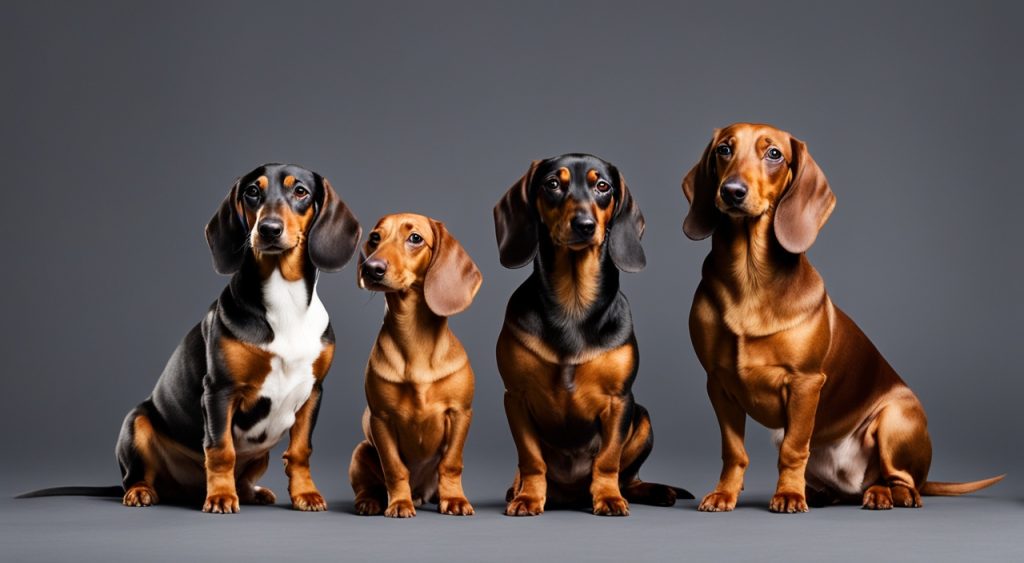
Size classifications vary by kennel club. The FCI uses chest measurements, while others rely on weight. This size variety makes dachshunds suitable for different living spaces.
| Size | Height | Weight | Chest Circumference |
|---|---|---|---|
| Standard | 8-9 inches | 16-32 pounds | >35 cm |
| Miniature | Up to 6 inches | <11 pounds | 30-35 cm |
| Kaninchen | <6 inches | <7.7 pounds | <30 cm |
All dachshunds share a long body and short legs. These unique features make them beloved companions. Their varied sizes add to their charm as popular pets worldwide.
Dachshund: The Personality of a Sausage Dog
Doxies, or hot dogs, have unique personalities that match their long bodies. These small pups are full of character, making them beloved companions for many dog lovers.
Brave and Determined Nature
Dachshunds were bred as hunting dogs, which shows in their brave nature. Despite their small size, they have a fearless attitude that often surprises owners.
Their high prey drive makes them great at flushing out small animals. This trait remains even in domestic settings.
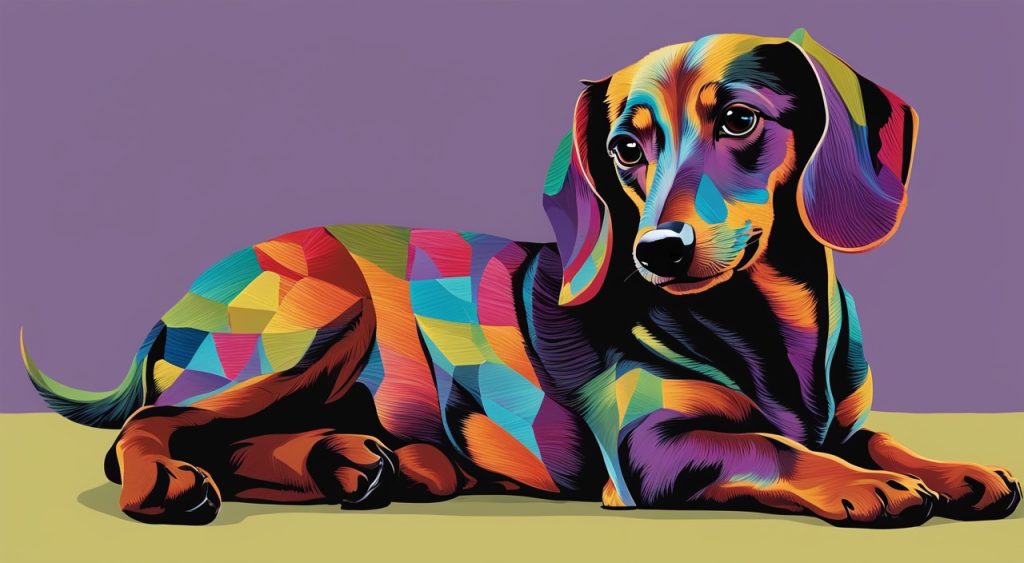
Playful and Affectionate Companions
Doxies are known for being playful and affectionate. They form strong bonds with their families, often choosing a favorite person.
These hot dogs love human interaction and enjoy being close to their owners. This makes them ideal lap dogs.
Stubborn Streak and Training Challenges
Dachshunds are smart, but their stubborn streak can make training tough. They may ignore commands, especially when distracted by potential prey.
Housebreaking can be hard, with some doxies taking up to a year to learn. Training these clever but willful pups requires patience and consistency.
| Trait | Description |
|---|---|
| Intelligence | High |
| Energy Level | Active |
| Loyalty | Strong |
| Trainability | Challenging |
Health Concerns and Longevity
Dachshunds, or sausage dogs, face unique health issues due to their body shape. Their long spine and short ribs make them prone to intervertebral disc disease (IVDD). Obesity, jumping, or intense exercise can worsen this condition.
Dachshunds typically live 12 to 16 years, longer than many other breeds. Regular vet check-ups help spot early signs of heart disease, diabetes, and dental problems.
Daily tooth brushing and cleanings prevent periodontal disease in dachshunds. This can stop systemic health issues. Excess weight stresses a dachshund’s spine and joints, leading to early musculoskeletal problems.
“A healthy dachshund is a happy dachshund. Regular exercise, a balanced diet, and lots of love can go a long way in ensuring your sausage dog lives a long, fulfilling life.”
Mental stimulation through training, puzzles, and games boosts a dachshund’s well-being. Affection, attention, and stable routines strengthen the emotional bond with your pet.
| Health Aspect | Importance for Dachshunds |
|---|---|
| Regular Vet Visits | Detect early signs of health issues |
| Dental Care | Prevent periodontal disease |
| Weight Management | Reduce stress on spine and joints |
| Mental Stimulation | Contribute to overall well-being |
| Emotional Bond | Enhance quality of life |
The Dachshund in Popular Culture
Dachshunds, lovingly called doxies, have made a big impact on popular culture. Their sausage-like shape and charming personalities have won hearts worldwide. These pups are truly unforgettable.
Olympic Mascot and Sporting Events
In 1972, Waldi the dachshund became the first official Olympic mascot. This colorful wiener dog represented the Munich Games, symbolizing athletes’ strength and determination.
Doxie races have entertained crowds since the 1970s. The Wienerschnitzel Weiner Nationals is a popular event featuring these short-legged speedsters. However, the Dachshund Club of America doesn’t endorse these races due to health concerns.
Dachshunds in Art and Media
Artists have long been inspired by these adorable pups. Pablo Picasso’s dachshund, Lump, appeared in 15 of his 58 paintings. These works were inspired by Velázquez’s “Las Meninas,” showcasing the breed’s artistic appeal.
Dachshunds often star in cartoons and toys, thanks to their unique look. Their popularity goes beyond visuals, ranking 12th among U.S. dog breeds in 2018. This ranking comes from the American Kennel Club.
| Dachshund Fact | Detail |
|---|---|
| Olympic Mascot | Waldi (1972 Munich Games) |
| Popular Race | Wienerschnitzel Weiner Nationals |
| Famous Artist’s Muse | Picasso’s dachshund, Lump |
| U.S. Popularity Ranking (2018) | 12th |
Caring for Your Dachshund
Dachshunds, or sausage dogs, are delightful companions. Their unique shape and lively spirit need special care. This ensures they live happy, healthy lives.
Exercise and Activity Needs
Dachshunds are small but energetic dogs. They need regular exercise to stay healthy and avoid weight gain. Standard dachshunds need about an hour of daily activity.
Miniature dachshunds require around 30 minutes. Activities can include walks, playtime, and fun games.
Grooming Requirements
Grooming needs depend on coat type. Smooth-haired dachshunds only need weekly brushing. Long-haired and wire-haired varieties need more frequent care.
Regular brushing prevents matting and keeps coats healthy. Don’t forget nail trimming and dental care!
Dietary Considerations
Good nutrition is vital for dachshunds. Feed them quality dog food suited to their age and size. Adult dachshunds should eat twice daily, while puppies need three to four meals.
Watch portion sizes to prevent obesity, which can harm their long backs. Avoid table scraps and bones to prevent stomach issues.
| Age | Feeding Frequency | Exercise Time |
|---|---|---|
| Puppy | 3-4 times daily | 5 min per month of age |
| Adult | 2 times daily | 30-60 min daily |
Each dachshund is special. Talk to your vet about a care plan for your sausage dog. With proper care, dachshunds can live 12-16 years.
Your dachshund will fill your home with joy and friendship for many years.
Dachshunds as Family Pets
Dachshunds, or wiener dogs, are great family pets. These small pups adapt well to various homes, including apartments. Their playful nature makes them perfect for families of all sizes.
Doxies come in different sizes and coat types. Standard and miniature dachshunds suit families with varying space needs. Their coats range from smooth to longhaired, each needing different grooming.
Dachshunds form strong bonds with their owners. However, they need proper training and socialization. Early training helps prevent issues like excessive barking or suspicion towards strangers.
| Trait | Description |
|---|---|
| Affection Level | High |
| Exercise Needs | Moderate |
| Intelligence | High |
| Trainability | Moderate (can be stubborn) |
| Grooming Needs | Varies by coat type |
Families should know about potential health issues, like back problems in dachshunds. Regular exercise and mental stimulation are important for these smart dogs. With patience, dachshunds can become beloved family members.
These pups bring joy and companionship to their homes. Consistent training helps shape them into ideal pets for any family.
Choosing a Dachshund: Adoption and Breeding Considerations
Dachshunds can live up to 16 years, so choosing one is a big decision. Adopting from a rescue can be rewarding. You’ll save a life and gain a loyal friend.
The ASPCA reports 670,000 dogs are euthanized yearly in U.S. shelters. By adopting, you’re making a difference. You’re also getting a devoted companion.
If you want a puppy, find a reputable breeder. Dachshund puppies usually cost between $500 and $3,000. Show-quality dogs may be priced up to $5,000.
Good breeders let you visit their facilities. They provide health clearances and keep clean environments. Be cautious of low prices or multiple litters available at once.
Owning a dachshund involves ongoing costs. You’ll need to budget for vet care, vaccinations, and supplies. Pet insurance can help with medical expenses.
The American Kennel Club ranks dachshunds as the 11th most popular breed in the U.S. This shows their charm and appeal. Be ready for the commitment and joy a dachshund brings.
FAQ
What is the origin of the Dachshund breed?
Dachshunds originated in Germany as hunting dogs for badgers. Their long bodies and short legs were designed for digging. These features helped them maneuver through tunnels easily.
What are the different coat varieties of Dachshunds?
Dachshunds have three coat varieties: smooth, long-haired, and wire-haired. Smooth coats are most popular in the US. In Germany, wire-haired coats are more common.
What are the different size variations of Dachshunds?
Dachshunds come in three sizes: standard, miniature, and kaninchen. Standard Dachshunds weigh 16-32 pounds, while miniatures weigh up to 11 pounds. Kaninchen, or rabbit size, weigh 8-11 pounds.
What is the personality of Dachshunds like?
Dachshunds are clever, lively, and courageous. They can be stubborn and challenging to train. Their strong prey drive may lead to chasing small animals.
These dogs can be aggressive towards strangers and other dogs. Proper socialization is important for Dachshunds.
What are the common health concerns for Dachshunds?
Dachshunds are prone to spinal problems, especially intervertebral disk disease (IVDD). Their long spine and short rib cage increase this risk. Obesity, jumping, and intense exercise can lead to injuries.
How have Dachshunds been featured in popular culture?
Dachshunds are popular in cartoons and toys due to their unique look. Waldi, a Dachshund, was the first Olympic mascot in 1972. Dachshund races, like the Wienerschnitzel Weiner Nationals, started in the 1970s.
What are the exercise and grooming needs of Dachshunds?
Dachshunds need regular exercise but should avoid straining their backs. Grooming needs vary by coat type. Long-haired and wire-haired Dachshunds require more frequent brushing.
Smooth-haired Dachshunds may need sweaters in cold weather. Regular grooming helps keep their coats healthy.
Are Dachshunds good family pets?
Dachshunds can be excellent family companions. They are known for being playful and affectionate. However, their stubbornness and potential aggression require proper training and socialization.
What should I consider when choosing a Dachshund?
Consider the different coat types and sizes when choosing a Dachshund. Be aware of potential health issues related to their body structure. Always get Dachshunds from reputable breeders or adoption organizations.
